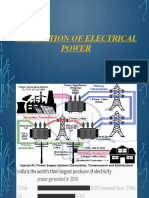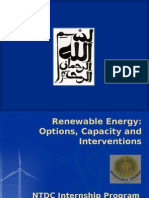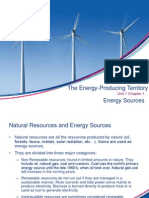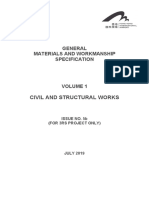0 ratings0% found this document useful (0 votes)
18 viewsChapter 1 - Lec 2
Chapter 1 - Lec 2
Uploaded by
Vinay PrakashThe document discusses various renewable and non-renewable energy sources, including their basic principles and limitations. It covers gas, water power, nuclear power, solar energy, wind energy, bio-gas, ocean thermal energy conversion, tidal energy, geothermal energy, hydrogen energy, fuel cells, magneto hydro dynamics generators, and thermionic converters. It also lists advantages and obstacles to implementing renewable energy.
Copyright:
© All Rights Reserved
Available Formats
Download as PPTX, PDF, TXT or read online from Scribd
Chapter 1 - Lec 2
Chapter 1 - Lec 2
Uploaded by
Vinay Prakash0 ratings0% found this document useful (0 votes)
18 views26 pagesThe document discusses various renewable and non-renewable energy sources, including their basic principles and limitations. It covers gas, water power, nuclear power, solar energy, wind energy, bio-gas, ocean thermal energy conversion, tidal energy, geothermal energy, hydrogen energy, fuel cells, magneto hydro dynamics generators, and thermionic converters. It also lists advantages and obstacles to implementing renewable energy.
Original Description:
non conventional
Original Title
Chapter 1_Lec 2
Copyright
© © All Rights Reserved
Available Formats
PPTX, PDF, TXT or read online from Scribd
Share this document
Did you find this document useful?
Is this content inappropriate?
The document discusses various renewable and non-renewable energy sources, including their basic principles and limitations. It covers gas, water power, nuclear power, solar energy, wind energy, bio-gas, ocean thermal energy conversion, tidal energy, geothermal energy, hydrogen energy, fuel cells, magneto hydro dynamics generators, and thermionic converters. It also lists advantages and obstacles to implementing renewable energy.
Copyright:
© All Rights Reserved
Available Formats
Download as PPTX, PDF, TXT or read online from Scribd
Download as pptx, pdf, or txt
0 ratings0% found this document useful (0 votes)
18 views26 pagesChapter 1 - Lec 2
Chapter 1 - Lec 2
Uploaded by
Vinay PrakashThe document discusses various renewable and non-renewable energy sources, including their basic principles and limitations. It covers gas, water power, nuclear power, solar energy, wind energy, bio-gas, ocean thermal energy conversion, tidal energy, geothermal energy, hydrogen energy, fuel cells, magneto hydro dynamics generators, and thermionic converters. It also lists advantages and obstacles to implementing renewable energy.
Copyright:
© All Rights Reserved
Available Formats
Download as PPTX, PDF, TXT or read online from Scribd
Download as pptx, pdf, or txt
You are on page 1of 26
GAS
• Gas is incompletely utilized
• Gas has high transportation cost
• Gas transportation is more costlier than oil
transportation
• Some gases used in industries are acetylene,
ethylene, methane
Water Power
• Potential energy of water is converted to mechanical
energy
• Capital Cost of hydroelectric plant is more but
operating cost is very low
• The development rate of hydropower is low because
1. 6-10 years on planning , investigating and
construction
2. High capital investment is needed
3. Relocation of villages
• Micro and mini hydro electric plants
Nuclear Power
• The controlled fission of unstable atoms like Uranium ,
Thorium liberate large amount of energy
• The heat produced is utilized in the heat exchangers for
the production of steam
• Limitation of nuclear energy
1. High capitol cost of nuclear plants
2. Limited availability of raw material
3. Difficulties with the disposal of radioactive waste
4. Shortage of well trained personnel.
Nuclear Power
• Uranium Reserves in India :
Jaduguda , Narwapahar, Bhattin ,
Singhbhum (Bihar).
• Thorium Reserves : In the form of
monazite sand in the west coast
• Nuclear Power Plants in India :
1. Tarapore nuclear power station
[Maharashtra] (400 MW)
2. Rana Pratab Sagar [Kota ,
Rajasthan] (400 MW)
3. Kalapakkam [Tamil Nadu] (440
MW)
4. Kakrapar [Gujrat] (940 MW)
Non Conventional Sources
• Fossil fuels will exhaust
in near future
• Systems based on
‘renewable’ sources are
being tried
• These are solar, wind,
sea, geothermal and
biomass
Solar Energy
• Solar energy has greatest potential of all the sources of
renewable energy
• The solar power which hits the atmosphere is 10^17
Watts
• The solar power on the earth surface is 10^13 Watts
• The total world-wide demand of all civilization is
10^10 Watts
• Sun gives us 1000 times more power than we need
• The energy radiated by the sun on a bright sunny day is
1KW/m^2
Solar Energy
• The basic research in solar energy is being carried in
universities, institutions and in BHEL and Central
Electronics Limited.
• The solar energy are enjoying most success in
1. Solar water heating
2. Solar drying of agriculture and animal products
3. Solar cookers
4. Solar engines for water pumping
5. Solar Electric power generation :
• Steam generators using reflectors
• Solar photovoltaic cells
Wind Energy
• Winds are caused due to :
1. Heating and cooling of atmosphere generating
conventional currents
2. The rotation of the earth with respect to
atmosphere
• The energy available from the wind is estimated
to be 1.6*10^7 MW
• Winds are used to run wind mill which is then
coupled to drive a electric generator
• High wind speeds are available in coastal areas
Wind Energy
• The practically suitable wind mills are
1. Multi blade type wind mill
2. Sail type wind mill
3. Propeller type wind mill
4. Savonius type wind mill
5. Darrieus type wind mill
• The first three are horizontal axis wind mills while
the last two are horizontal type wind mills
Energy from Bio-gas
• The potential for bio gas as an alternate source of energy in
India is very great
• The main source of production of bio-gas is wet cow dung
• India has large cattle population (250 million )
• Some other sources of bio-gas are
1. Sewage
2. Crop residue
3. Vegetable waste
4. Poultry droppings
5. Pig-manures
6. Algae
Energy from bio-gas
• Bio-gas thus produced can
be used to run pumps
• The bio-gas is found to
contain 84 % of methane
• Methane could be
economically used to run
engines to drive electric
generator
• In rural sectors, bio-gas
finds applications in
cooking, lightning and
generation of small
electricity
Ocean Thermal Energy Conversion
• The surface of water acts as collector for solar
heat
• The temperature difference between the warm
surface water of tropical oceans and colder
waters in the depths is about 20-25 degree K
• The surface water at higher temperature could
be used to heat some low boiling organic fluid
• The vapors are condensed by pumping cold
water from deeper regions
Ocean Thermal Energy Conversion
• The huge amount of
energy is available from
OTEC
• Largest OTEC is in
France with 7.5 MW
capacity
• In India department of
non conventional energy
(DNES) sources has
proposed 1 MW plant in
Lakshadweep
Tidal Energy
• The tides in the sea are the results of universal
gravitational effects
• The periodic rise and fall of the water level of sea
is called as tide
• To harness the tides, a dam is built , it will have
large gates and a low head reversible turbines
• By the use of reversible turbines , turbines can run
continuously during high tide and low tides.
Tidal Energy
Geothermal Energy
• Geothermal energy is the energy which lies embedded
within the earth
• The steam and hot water comes naturally to the surface of
the earth in some locations (Hot water geysers)
• Two ways of electric power production from geothermal are
:
1. Heat energy is transferred to a working fluid which
operates power cycle
2. The hot geothermal steam is used to operate turbines
directly
• At present only steam coming out of ground is used to
generate electricity
• Hot water contains dissolved salts and minerals
Geothermal Energy
• Research is being carried out to build turbines
which can withstand the corrosive effects of
hot water
• Himachal Pradesh is reported to have
enormous amount of geothermal energy
• World’s first geothermal power station was
established at Lardarello in Italy in 1905, 450
MW
• Wairaki , New Zealand , 250 MW
Hydrogen Energy
• Hydrogen energy can play an important
alternative to conventional fuels
• Hydrogen can be produced from water which
is available abundantly in nature
• Hydrogen has highest energy content per unit
of mass
• Its burning process is non polluting
• It is used in fuel cells to produce electricity
Fuel Cells
• Fuels cells convert the chemical energy to
electrical energy
• It is distinguished from battery in that it operates
on the continues replenishment of the fuel
• Hydrogen oxygen fuel cells (Hydrox) are efficient
and most highly developed
• Two porous carbon or nickel electrodes
• Electrolyte is typically 30 % KOH
• Hydrogen and oxygen is fuel
Fuel Cells
• A single hydrogen cell can produce an EMF of 1.23
volts. Cells can be connected in series to form the
voltage level of 100 to 1000 volts.
• Power levels of 1 KW to 100 MW can be achieved
• Fuel cells involve direct conversion process
• The unit is lighter, smaller, needs less maintenance
• Little pollution, little noise , accepted in residential
areas
• The primary drawbacks are their low voltage and
high initial costs , low service life
Magneto Hydro Dynamics Generator
• MHD Generators are based on faradays law of induction
• In MHD generators, the solid conductors are replaced by a fluid
which is electrically conducting
• The working fluid may be ionized gas or liquid metal
• Ionized gas is expanded in a duct, and forced through a strong
magnetic field
• Ionized gas can be produced by heating it to high temperature
• High temperature in excess of 2800 degree Celsius is needed to
produce ionized gas
• Seeding the gas with potassium or cesium helps in ionization
• The system has no moving part
• The system can be brought to full power in 45 seconds.
Thermionic Converter
• Heat energy to electrical energy
• Set up consists of two electrodes
• Heating one electrode boils out electrons that flow
travel to opposite colder electrodes
• The electrons flow though resistor to develop electric
power
• Anode materials (Collector ) : Barium , strontium
oxides
• Cathode materials (Emitter ) : tungsten with barium
compound
• These systems have efficiency of 8%
Advantages of renewable energy
1. Indigenous resources available in considerable quantities
2. Renewable options are financially and economically
competitive, such as in remote locations where the costs of
transmitting electrical power are high
3. Reduced transmission and distribution cost
4. The resources are environmental friendly , no pollution is
created
5. Ease in adding new units
Obstacles to the implementation of
renewable energy
1. Weak or non-existent of the policies to finance
and commercialize renewable energy systems.
2. High economic and financial costs
3. Technical and economic uncertainties in many
renewable energy systems
4. Lower efficiencies of the systems
5. Problems with the integration of these
technologies with the Utility grid.
6. Complex control circuitries
You might also like
- Woodward P.M., Karen P., Evans J.S.O., Vogt T. - Solid State Materials Chemistry-Cambridge University Press (2021)Document706 pagesWoodward P.M., Karen P., Evans J.S.O., Vogt T. - Solid State Materials Chemistry-Cambridge University Press (2021)Preyansh SrivastavaNo ratings yet
- Power Plant Question Bank Answer KeyDocument112 pagesPower Plant Question Bank Answer Keysistersound100% (3)
- Geothermal PPT For Presentation)Document27 pagesGeothermal PPT For Presentation)anil patel50% (4)
- Rewocare HV 100 - ApresentaçãoDocument12 pagesRewocare HV 100 - Apresentaçãohenriquefxs2926No ratings yet
- Generation of Electrical PowerDocument44 pagesGeneration of Electrical PowerMohanNo ratings yet
- Energy ResourcesDocument36 pagesEnergy ResourcesHarjot KaurNo ratings yet
- Energy Management - Ivin & TeamDocument27 pagesEnergy Management - Ivin & TeamIvin MichaelNo ratings yet
- GEOTHERMAL ENERGY PowerPointDocument25 pagesGEOTHERMAL ENERGY PowerPointRene RamiloNo ratings yet
- YfytDocument19 pagesYfytNaveen Raj ENo ratings yet
- Geothermal Energy PowerpointDocument19 pagesGeothermal Energy PowerpointgilangNo ratings yet
- Aee Slides1Document46 pagesAee Slides1kannanNo ratings yet
- Chapter 2 Whole Chapter NotesDocument49 pagesChapter 2 Whole Chapter NotesWafula RobertNo ratings yet
- Geothermal EnergyDocument19 pagesGeothermal EnergyGanesh harikantraNo ratings yet
- 1) Conventional - Non Renewable Power GenerationDocument49 pages1) Conventional - Non Renewable Power GenerationManmit SalunkeNo ratings yet
- Renewable Energy in Global PerspectiveDocument43 pagesRenewable Energy in Global PerspectiveKhalil RazaNo ratings yet
- Energy Sources, Work and PowerDocument50 pagesEnergy Sources, Work and PowerjessicaNo ratings yet
- Chapter 11 - Energy Sources, Work and PowerDocument43 pagesChapter 11 - Energy Sources, Work and PowerUapi MuukuaNo ratings yet
- Yaswanth Paper Presentation 1508123456Document14 pagesYaswanth Paper Presentation 1508123456YaswanthNo ratings yet
- Energy Crisis in PakistanDocument10 pagesEnergy Crisis in PakistankryptozgamerNo ratings yet
- Module 5Document45 pagesModule 5Stephen RajNo ratings yet
- Renewable EnergyDocument16 pagesRenewable EnergyMd Shuvo KhanNo ratings yet
- Week 1Document15 pagesWeek 1Zeynep TokelNo ratings yet
- Unit 4 Power PlantsDocument136 pagesUnit 4 Power PlantsSachidhanandam MNo ratings yet
- Welcome: Viable Proposition To Harness The Fire Inside The Earth To Produce Geothermal Power in Large ScaleDocument14 pagesWelcome: Viable Proposition To Harness The Fire Inside The Earth To Produce Geothermal Power in Large Scalerashpal4No ratings yet
- Importance of Electrical EnergyDocument65 pagesImportance of Electrical EnergytawqeerNo ratings yet
- Power Chapter 1.2Document30 pagesPower Chapter 1.2krishna sankar .Mani.No ratings yet
- Power Generation TechnicsDocument4 pagesPower Generation Technicspurna4078No ratings yet
- Renewable Energy: Options, Capacity and InterventionsDocument50 pagesRenewable Energy: Options, Capacity and InterventionsMuhammad Salman ArshidNo ratings yet
- Module 1.2Document34 pagesModule 1.2Aswathy A MNo ratings yet
- ORO551 Unit 5 Geothermal EnergyDocument58 pagesORO551 Unit 5 Geothermal EnergyRakshambika RNNo ratings yet
- RET 102-Introduction To Geothermal Energy-L1Document23 pagesRET 102-Introduction To Geothermal Energy-L1jenty neemaNo ratings yet
- Lecture 1a. Choice of energy source. RenewablesDocument47 pagesLecture 1a. Choice of energy source. RenewablesIgombe IsaacNo ratings yet
- Alternative Energy-Science2Document30 pagesAlternative Energy-Science2api-210392915No ratings yet
- Evs - Final Unit 4 - Innovative Business and EnvironementDocument66 pagesEvs - Final Unit 4 - Innovative Business and EnvironementNidhi PeshwaniNo ratings yet
- 1.1Document44 pages1.1akshayspai.mecNo ratings yet
- Unit 1 The Energy Producing SourcesDocument45 pagesUnit 1 The Energy Producing Sourcesapi-241427002No ratings yet
- Energy Engineering: Introduction To Energy, Energy Resources & Overview of Energy Demand (World & Pakistan)Document54 pagesEnergy Engineering: Introduction To Energy, Energy Resources & Overview of Energy Demand (World & Pakistan)Awais SalahuddinNo ratings yet
- Energy Stores and Transfers PresentationDocument15 pagesEnergy Stores and Transfers PresentationSaba KhanNo ratings yet
- RES - Module 1Document82 pagesRES - Module 1B.R. RESHMANo ratings yet
- University of Caloocan City: Geothermal EnergyDocument6 pagesUniversity of Caloocan City: Geothermal EnergyAnna Liza Lope - MotolNo ratings yet
- c55xxnfswgdresnekbhs-signature-1c5128afbd5d601be9fad388c20e051d7bed85828d375dba80fe7347eacd1819-poli-151010081544-lva1-app6891 (1)Document32 pagesc55xxnfswgdresnekbhs-signature-1c5128afbd5d601be9fad388c20e051d7bed85828d375dba80fe7347eacd1819-poli-151010081544-lva1-app6891 (1)michelle velascoNo ratings yet
- G5 Renewable EnergyDocument19 pagesG5 Renewable EnergyDan Gerico L. BacaniNo ratings yet
- Environment Science (SEM-2, UNIT-1) Natural ResourcesDocument37 pagesEnvironment Science (SEM-2, UNIT-1) Natural ResourcesnamrataNo ratings yet
- Unit 3A BeeeDocument15 pagesUnit 3A Beeejvharsha.sNo ratings yet
- Renewable Sources of Energy1Document18 pagesRenewable Sources of Energy1Arpit KapoorNo ratings yet
- Renewables Lecture - GarthDocument37 pagesRenewables Lecture - GarthNitesh BorkarNo ratings yet
- Energy Resources NotesDocument8 pagesEnergy Resources NotesNajam SaqibNo ratings yet
- Marine Propulsion Engines and Renewable Energies: NME 463 By: Dr. Waleed YehiaDocument33 pagesMarine Propulsion Engines and Renewable Energies: NME 463 By: Dr. Waleed YehiawaleedyehiaNo ratings yet
- EEE Notes Unit 3 Conventional Energy Resources PDFDocument8 pagesEEE Notes Unit 3 Conventional Energy Resources PDFAyush NandurkarNo ratings yet
- Geothermal PlantDocument24 pagesGeothermal PlantVikasMantri100% (1)
- Alternative Sources of Energy in DetailDocument22 pagesAlternative Sources of Energy in DetailPRIYA MISHRANo ratings yet
- Quarter 3 Weeks 3-4Document39 pagesQuarter 3 Weeks 3-4Patricia SamsonNo ratings yet
- Report On Geoothermal EnergyDocument14 pagesReport On Geoothermal EnergyPraveen YadavNo ratings yet
- Energy in EnvironmentDocument49 pagesEnergy in EnvironmentFurqan SaeedNo ratings yet
- Earth Science Lesson 3.33.4Document22 pagesEarth Science Lesson 3.33.4Ana Marie Corales TabunarNo ratings yet
- UNIT - 3 BCME FinalDocument26 pagesUNIT - 3 BCME FinalAnith Kumar ReddyNo ratings yet
- 007Document28 pages007shantanubanerjee.mec24No ratings yet
- Energy SourcesDocument40 pagesEnergy SourcesRamil Cachuela100% (3)
- GEGC CH 1 Introduction GEGCDocument28 pagesGEGC CH 1 Introduction GEGCRiaz IsraniNo ratings yet
- Chapter 2.1 EnergyDocument40 pagesChapter 2.1 EnergyTeresa YanNo ratings yet
- Lecture 2Document43 pagesLecture 2shahzodrahmatillayev12No ratings yet
- RENEWABLE ENERGY: Solar, wind and other sources for a sustainable futureFrom EverandRENEWABLE ENERGY: Solar, wind and other sources for a sustainable futureRating: 4.5 out of 5 stars4.5/5 (3)
- Value Based QuestionsDocument1 pageValue Based QuestionsVinay PrakashNo ratings yet
- Value Based QuestionsDocument1 pageValue Based QuestionsVinay PrakashNo ratings yet
- Organic Compounds Containg NitrogenDocument2 pagesOrganic Compounds Containg NitrogenVinay PrakashNo ratings yet
- Pel101-Communication Skills-I: Lecture-10 WEEK-5 Designed by Ruchika Verma, 13422Document43 pagesPel101-Communication Skills-I: Lecture-10 WEEK-5 Designed by Ruchika Verma, 13422Vinay PrakashNo ratings yet
- The Insolvency and Bankruptcy Code (AMENDMENT) ACT, 2017Document21 pagesThe Insolvency and Bankruptcy Code (AMENDMENT) ACT, 2017Vinay PrakashNo ratings yet
- L11 ArrayListDocument13 pagesL11 ArrayListVinay PrakashNo ratings yet
- Biomolecules Value Based Questions 1. The Teacher Fixed Five Cards On The Flannel Board That Marked A, T, C, U, GDocument2 pagesBiomolecules Value Based Questions 1. The Teacher Fixed Five Cards On The Flannel Board That Marked A, T, C, U, GVinay PrakashNo ratings yet
- UNIT - I Alphabet TestDocument24 pagesUNIT - I Alphabet TestVinay PrakashNo ratings yet
- UNIT - IV SyllogismDocument52 pagesUNIT - IV SyllogismVinay PrakashNo ratings yet
- Series Completion TutorialDocument9 pagesSeries Completion TutorialVinay PrakashNo ratings yet
- Sequential OutputDocument42 pagesSequential OutputVinay PrakashNo ratings yet
- Coding Decoding TutorialDocument13 pagesCoding Decoding TutorialVinay PrakashNo ratings yet
- UNIT - I Alphabet TestDocument24 pagesUNIT - I Alphabet TestVinay PrakashNo ratings yet
- Coding Decoding TutorialDocument13 pagesCoding Decoding TutorialVinay PrakashNo ratings yet
- Gross Profit Ratio Net Profit Ratio Quick Assets Ratio Debtors Collection Period Stock Turnover Ratio Current Ratio Debt Equity RatioDocument5 pagesGross Profit Ratio Net Profit Ratio Quick Assets Ratio Debtors Collection Period Stock Turnover Ratio Current Ratio Debt Equity RatioVinay PrakashNo ratings yet
- Steam ExcelDocument12 pagesSteam Excelsid sNo ratings yet
- Grinding WheelsDocument26 pagesGrinding Wheelsznovak77No ratings yet
- Ch4502 DMG pdf-2Document3 pagesCh4502 DMG pdf-2Karan RavalNo ratings yet
- Exp 1 Chm510Document11 pagesExp 1 Chm510Nur Nadia Syahira100% (1)
- Detection of CationsDocument3 pagesDetection of CationsFake XZVONo ratings yet
- Pressure Vessels IntroductionDocument4 pagesPressure Vessels IntroductionCepi Sindang KamulanNo ratings yet
- Safety Data Sheet Calcium Acetate, Monohydrate: Section 1 Product DescriptionDocument4 pagesSafety Data Sheet Calcium Acetate, Monohydrate: Section 1 Product DescriptionQamir Ullah Khan NiaziNo ratings yet
- Role of Transient Creep in Fire Induced Progressive Collapse of Steel Framed BuildingsDocument9 pagesRole of Transient Creep in Fire Induced Progressive Collapse of Steel Framed Buildingsjackcan501No ratings yet
- Cambridge O Level: Chemistry 5070/31 October/November 2021Document7 pagesCambridge O Level: Chemistry 5070/31 October/November 2021For GamingNo ratings yet
- US2321218Document3 pagesUS2321218shirazizadehsinaNo ratings yet
- Point 1 Point 2 Point 3 Point 4 Point 5Document15 pagesPoint 1 Point 2 Point 3 Point 4 Point 5Annisa Prita MelindaNo ratings yet
- Memming 1966Document16 pagesMemming 1966Luisa CenchaNo ratings yet
- Polymer Exam 2222Document8 pagesPolymer Exam 2222wondimuNo ratings yet
- Extraction of Nuclear and Non-Ferrous Metals by Sujay Kumar Dutta, DharmeshDocument247 pagesExtraction of Nuclear and Non-Ferrous Metals by Sujay Kumar Dutta, DharmeshUlises Quintana Carhuancho50% (2)
- Bromine Water - Saturated MSDS: Section 1: Chemical Product and Company IdentificationDocument5 pagesBromine Water - Saturated MSDS: Section 1: Chemical Product and Company IdentificationWinonaNo ratings yet
- 7.1.4.1.4 Determination of Optical Rotation and Specific RoDocument2 pages7.1.4.1.4 Determination of Optical Rotation and Specific RoEleanor Seño-MenchavezNo ratings yet
- 2013 - Laguna Camacho - A Study of Cavitation Erosion On Engineering MaterialsDocument10 pages2013 - Laguna Camacho - A Study of Cavitation Erosion On Engineering MaterialsCesar Fernando BenavidesNo ratings yet
- Week 5 & 6Document10 pagesWeek 5 & 6Mariel MirafloresNo ratings yet
- Q1Document40 pagesQ1agsierraqNo ratings yet
- Lab 2 Moisture and Clay Contents Determination of Moulding SandDocument2 pagesLab 2 Moisture and Clay Contents Determination of Moulding SandTommy MilesNo ratings yet
- Composite Lecture 2Document28 pagesComposite Lecture 2wardell 30No ratings yet
- Battery Recycling: Lead Reclamation From Spent BatteriesDocument9 pagesBattery Recycling: Lead Reclamation From Spent BatteriesAndy Eloy Lora RodriguezNo ratings yet
- Hkaa Gm&Ws - July 2019Document2 pagesHkaa Gm&Ws - July 2019Alvin To AAHK0% (1)
- Sri Chaitanya: IndiaDocument9 pagesSri Chaitanya: IndiaTanvir ShafalNo ratings yet
- 55-4-1 PhysicsDocument19 pages55-4-1 Physicsvikas aggarwalNo ratings yet
- Balmoral Newsletter Chemicals 2019 Q2Document9 pagesBalmoral Newsletter Chemicals 2019 Q2CDI Global IndiaNo ratings yet
- Paint Master Hi Gloss - SDSDocument3 pagesPaint Master Hi Gloss - SDSMichael JoudalNo ratings yet
- Diagramma Entalpico R600aDocument1 pageDiagramma Entalpico R600aJesus YujraNo ratings yet






































































































